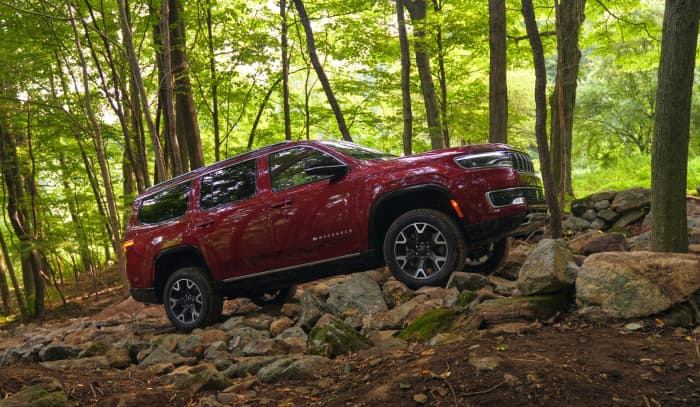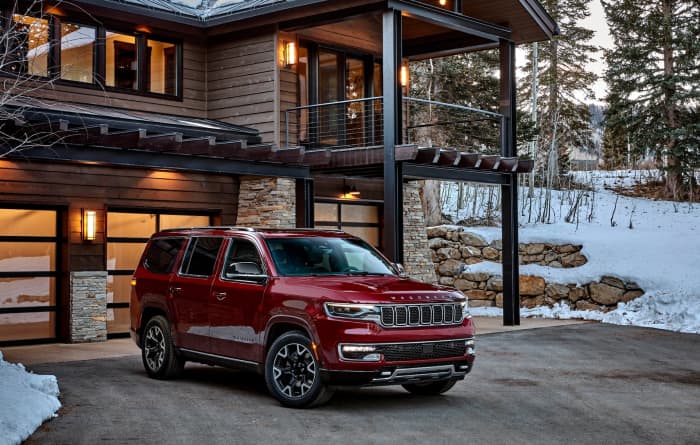Pros
- Roomy cabin
- Great engine
- Two sizes
Cons
- Larger than necessary for some
What’s new?
- V8 discontinued
The 2024 Jeep Wagoneer and its longer brother, the Wagoneer L, are spacious full-size SUVs with some off-road talents. Pricing starts at $ 62,545.
Offering comfortable accommodation for up to eight, as well as the ability to take a massive amount of luggage in the extended-length L variant, the Jeep Wagoneer is a must-consider for big families — especially those who like outdoorsy pursuits. This lineup of large SUVs is the newest on the block. The standard-length version made its debut for 2022 and the longer L arrived last year. Jeep took its sweet time diving into this class, but the results illustrate how that time was used wisely. Given their composure, refinement, comfort, spaciousness, and off-road ability, the Wagoneer and Wagoneer L are already serious contenders in a class once dominated by the Chevrolet Tahoe and Suburban. The grander, more luxurious Jeep Grand Wagoneer is reviewed separately.
What’s new for 2024
Jeep has ditched the 5.7-liter V8 that powered last year’s base Wagoneer. So the entire range is powered by a perfectly fine turbocharged 6-cylinder engine.
2024 Jeep Wagoneer pricing

The 2024 Jeep Wagoneer
Stellantis
The 2024 Jeep Wagoneer starts at $ 62,545. That would be for the standard-length base model with rear-wheel drive. The long-wheelbase body and 4-wheel drive each cost an extra $ 3,000, and every Wagoneer L has 4WD, except in the base trim. 4WD is also standard in the Series III models.
| Wagoneer | $ 62,545 |
| Wagoneer Series II | $ 68,340 |
| Wagoneer Carbide | $ 72,035 |
| Wagoneer Series III | $ 78,840 |
| Wagoneer L | $ 65,545 |
| Wagoneer L Series II | $ 74,340 |
| Wagoneer L Carbide | $ 78,035 |
| Wagoneer L Series III | $ 81,840 |
These are manufacturer’s suggested retail prices (MSRP) and don’t include the $ 2,000 factory-to-dealer delivery fee (destination charge).
Rivals like the Ford F, -2.48% Expedition (from $ 55.5K) and Chevrolet Tahoe (also beginning in the mid-$ 50Ks) have extended-length variants. There’s the Expedition Max (from $ 62.6K) and the Chevy Suburban (starting in the high $ 50Ks). Other rivals include the GMC Yukon/Yukon XL (starting in the high $ 50Ks/high $ 60Ks), as well as the Toyota Sequoia, priced from the low $ 60Ks. Before buying a new Wagoneer or Wagoneer L, check the Kelley Blue Book Fair Purchase Price to know what you should be paying. Resale values are about average for the class.
Power, ride, and handling

The 2024 Jeep Wagoneer
Stellantis
The Wagoneer and Wagoneer L employ a twin-turbocharged 3.0-liter 6-cylinder engine making a perfectly acceptable 420 horsepower. The standstill-to-60 mph metric is a bit ludicrous for a full-size SUV, but we reckon it’ll do the dash in just under seven seconds, which is respectable enough. We’ve found that there’s plenty of thrust for passing maneuvers and getting up to freeway speed. Once on the freeway, it runs at 70 mph below 2,000 rpm — nice and relaxed. When we drove a Carbide model with the air suspension, we noticed the ride quality was a little on the firm side, but we came to appreciate this aspect because it meant the Wagoneer felt composed and smaller than it really is when we reached a stretch of curving mountain roads. The steering feels light but not over-assisted, while the brakes feel similarly natural.
We’ve spent hundreds of hours driving and evaluating this generation of full-size SUVs, including the Jeep Wagoneer and Wagoneer L.
Also see: The 2024 Honda Pilot vs. the Kia Telluride: How these 2 top SUVs compare
Fuel economy
The rear-wheel-drive Wagoneer and Wagoneer L both achieve 20 mpg in a combination of city and highway driving. Swap in 4-wheel drive and economy dips only by one mile per gallon. The L has a larger gas tank, so has a longer range: 610 miles with the rear-drive model. Regular 87-octane gasoline is fine, but Jeep recommends using the 89-octane stuff to get the best performance.
Spacious interior
Seating for eight is standard in both the 2024 Wagoneer and the Wagoneer L. A pair of optional captain’s chairs for the second row raises the comfort level but drops the occupant count to seven. Although the Wagoneer L sees no increase in passenger space compared with its standard-length counterpart, this is hardly a downside. Put a 6-footer in the front row, and someone of the same height will sit comfortably in the second row. Then another 6-footer can fit in the third. There are 42.7 inches of legroom in row two and 36.6 inches in row three.
Up front, Jeep has managed to keep all the controls and switchgear remarkably tidy. And although there are three screens available (even the front passenger can have one), the overall feel is more warmly human than cooly technical. The rest of the cabin is quite luxurious. Leather seating surfaces are standard at the entry-level, with quality improving in higher trims. Eight-way power-adjustable front seats, along with memory settings on the driver’s side, are also standard. The Wagoneer L also adds a couple of 1.8-liter storage areas for third-row passengers.
The big winner in the extended Wagoneer L is cargo space — almost 16 cubic feet more. This breaks down to 44.2 cubic feet behind the rearmost seats, 88.8 behind the second row, and 130.9 cubic feet behind the front seats. According to Jeep, a 4-by-8 sheet of plywood goes in without problem. For comparison, cargo space in a Chevy Suburban goes from 41.5 to 144.7 cubic feet.
Read: Should you get an SUV or a minivan? Here are the pros and cons of both.
Characterful exterior
Thanks to Jeep’s usual rugged styling approach, we think there’s more character to the Wagoneer pair than their rivals from Ford and General Motors. And there’s even more of that character in the Wagoneer L, which measures 19 feet long and has a 12-inch advantage over its non-L counterpart. But that also makes it more unwieldy in parking situations, so if you don’t need the extra room, we recommend sticking with the “short” version (which is still longer than Tahoe and Expedition). Keeping an eye on weight, Jeep has fashioned the hood and doors from aluminum and used composite materials for the tailgate.
Our favorite features and tech
User profiles
The Wagoneer allows up to five user profiles, loading individual preferences for seating, heating, and listening.
Wireless Apple CarPlay/Android Auto
Cable-free smartphone integration is just one standard attribute of an infotainment system that has over-the-air updates, responds to natural voice commands, and offers up to 11 USB ports, as well as Wi-Fi connectivity for up to eight devices.
Amazon Alexa compatibility
This infotainment system can also connect with Amazon’s AMZN, +1.18% digital assistant (order a picnic from Whole Foods, maybe), plus Amazon Fire TV — enabling passengers to access apps, TV shows, and movies.
4-wheel drive
Not many Wagoneer SUVs will clamber over rocks, but Jeep offers three 4-wheel drive systems of increasing sophistication.
ParkSense Automated Parking System
In a vehicle of this size, a self-parking feature for parallel and perpendicular spaces sounds like everyone’s first selection from the options list.
McIntosh audio
McIntosh is a top-flight American company and has developed this 19-speaker/950-watt surround-sound system specifically for Jeep. It even includes the audio company’s particular blue meters.
Quadra-Lift air suspension
Part of the optional Convenience Group, this feature includes the ability to raise the ride height in off-road situations or lower it for optimum aerodynamics and easier entries and exits.
Engine and transmission
If our assumptions are correct, the 2024 Wagoneer/Wagoneer L lineup employs one engine in all variants. It’s a twin-turbocharged 3.0-liter 6-cylinder unit — configured not as the more common V6, but in the naturally smooth inline arrangement. Output is 420 horsepower and 468 lb-ft of torque, which goes through an 8-speed automatic transmission to either the rear wheels in standard form, or to an optional 4-wheel drive system. Maximum towing ability is an impressive 10,000 pounds.
Don’t miss: Here’s your ultimate list of best-buy cars, trucks, SUVs and EVs for 2024
3-year/36,000-mile warranty
Jeep’s new-vehicle warranty lasts three years or 36,000 miles, whichever happens first. Powertrains are covered for five years or 60,000 miles. These terms are typical for the category. Jeep also includes three years of free scheduled maintenance, which isn’t so usual.
Safety ratings
The Wagoneer has yet to be crash-tested by any agencies in the United States. Standard safety equipment includes forward collision warning with automatic emergency braking and pedestrian/cyclist detection, plus blind-spot monitoring with rear cross-path detection.
KBB’s car review methodology.
This story originally ran on KBB.com.
